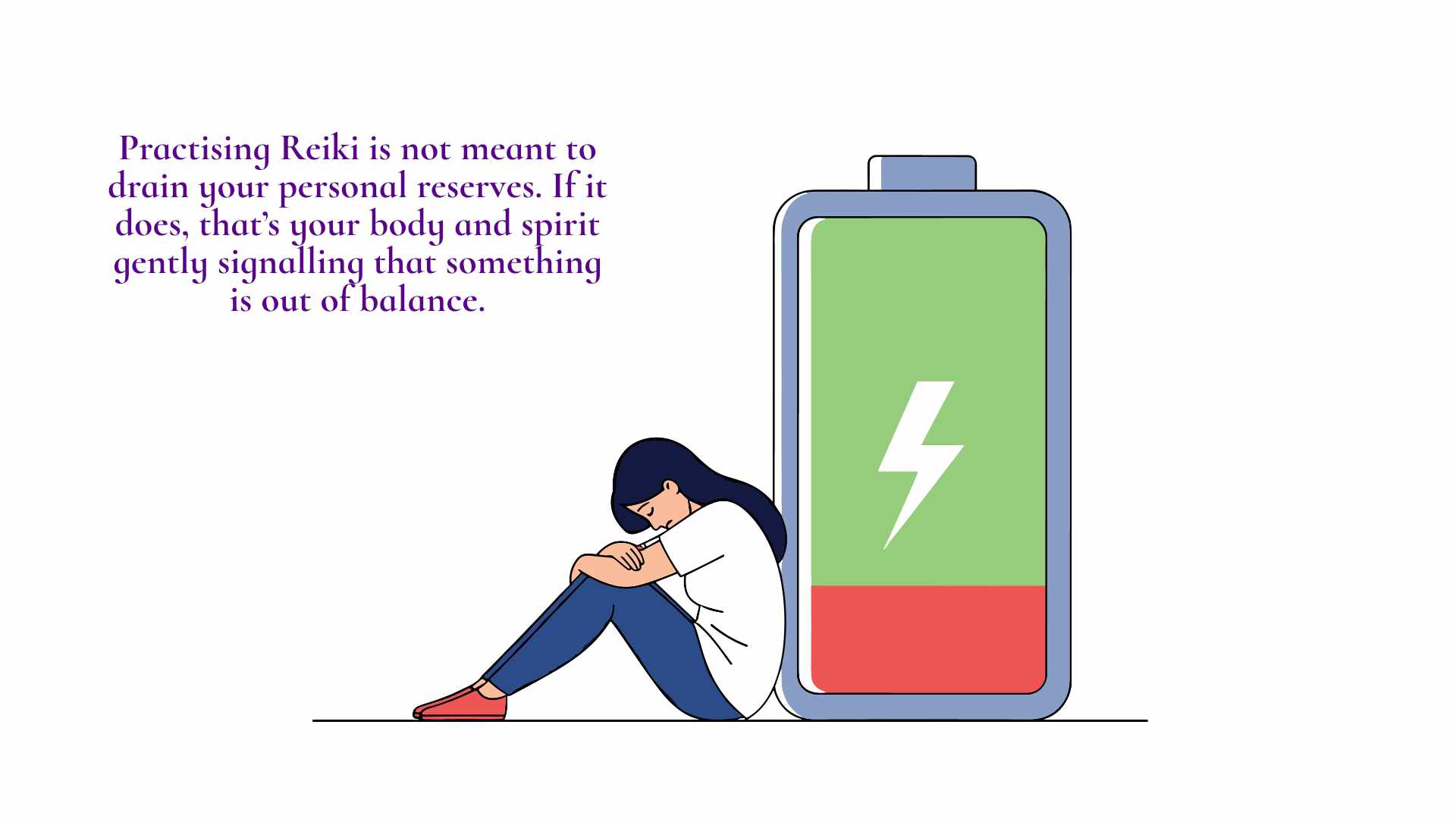Table of Contents
Table of Contents
Why Reiki Practitioners Shouldn’t Feel Drained (And What It Means If They Do)
“Don’t you get tired giving Reiki?” It’s a question I hear often, sometimes asked with genuine curiosity, other times with a hint of concern. My answer is always the same: Absolutely not.
And nor should any Reiki Practitioner.
If you are left feeling depleted after a Reiki session, it isn’t simply because you’ve “given too much.” It usually means something subtle has gone off track in the way you’re approaching your practice. It’s a signpost worth paying attention to — not just for your own health, but for the integrity of your healing work as a Reiki Practitioner.
The Role of Ego in Reiki Practice
When I began teaching Reiki, I quickly realised that one of the hardest lessons for any Reiki Practitioner to learn isn’t how to place their hands or remember a symbol. It’s learning to step out of the way.
The ego often gets a bad reputation in spiritual practice. Some teachings cast it as an enemy to be destroyed. I don’t see it that way. The ego is part of being human. Without it, I couldn’t run workshops, write this blog, or show up for my clients. Ego is the quiet voice that says, “You’ve got this.”
The difficulty arises when the ego climbs into the driver’s seat during a Reiki session.
When a Reiki Practitioner starts to believe that they are personally responsible for healing their client, two things happen:
• They begin to draw on their own reserves of energy, willpower, and focus, which is exhausting.
• They unconsciously disempower the client, taking away the essential truth that healing always comes from within.
Reiki isn’t about fixing someone else. It’s about creating space for the flow of universal energy — a flow that is far wiser and more intelligent than our personal will.
Stepping aside doesn’t mean abandoning the client. It means trusting the process and allowing Reiki to move in the way it needs to — without interference, without agenda.

The True Responsibility of the Reiki Practitioner
So, if we’re not here to “heal” our clients, what exactly is our responsibility as Reiki Practitioners?
It comes down to three things:
1. Creating a safe, comfortable space — Healing unfolds when the client feels secure, seen, and held without judgment. That might mean something as simple as adjusting the lighting, offering a blanket, and practising mindful listening before and after the session.
2. Being the clearest channel possible — Reiki doesn’t ask us to be perfect human beings — but it does invite us to tend to ourselves so that we can show up well for others. Daily self-Reiki, meditation, grounding practices, and a lifestyle that supports rather than depletes are all part of this.
3. Knowing our limits — Perhaps the most crucial responsibility of all. There are times when we are not in the right state to treat others. Maybe we’re ill, emotionally raw, or energetically depleted. If you need Reiki more than your client does, then your focus should be on your own healing, not theirs.
When practitioners ignore these truths, burnout isn’t far away. And once again, it’s the ego that whispers, “You should be able to do it all.”
The Practitioner’s Healing Too
One of the things I love most about being a Reiki Practitioner is that every session supports not only the client but also the practitioner. It’s part of the grace of Reiki: you can never give without receiving.
That said, there are limits. Reiki isn’t a magic shield that makes us immune to life. Practitioners are human, with bills to pay, relationships to navigate, losses to grieve, and health challenges to manage.
Over the years, I’ve met many incredible Reiki Practitioners who felt they had to keep showing up, even when life had knocked them flat. They feared that stepping back would make them “less spiritual” or “not professional enough.”
Here’s the truth: it’s not a weakness to pause. It’s integrity. It shows you are living the very principles you encourage others to explore — honesty, compassion, and balance.
You don’t have to be perfect to practise Reiki. What does matter is recognising your own limits and honouring them. When you do, you protect your well-being and the integrity of your practice.
Signs You Might Be Giving From Your Own Energy
If you’ve ever felt drained after a session, it’s worth asking yourself: was I stepping aside, or was I trying to push something through?
A few gentle signs that you may have slipped into using your own energy include:
• Feeling unusually tired, heavy, or “flat” afterwards.
• Experiencing a sense of frustration if the client didn’t respond the way you hoped.
• Holding tension in your body during the session (for example, clenched jaw, tight shoulders).
• A lingering thought of, “Did I do enough?”
These are invitations to pause, reflect, and realign with the truth that it is Reiki together with the client that does the work — not you.
Ego, Responsibility, and Empowerment
When Reiki Practitioners assume responsibility for their clients’ healing, something subtle but essential is taken away: empowerment.
If the Reiki practitioner carries the belief, “I will fix you,” the client may walk away believing they can only heal if someone else does it for them. But when the practitioner steps aside and simply holds the space, the client has the chance to feel their own agency. They experience themselves as capable, resilient, and resourceful. That’s where true transformation begins.
Reiki, at its heart, is not about dependency. It’s about awakening people to their own capacity for healing.
Practical Ways to Stay Balanced as a Reiki Practitioner
While Reiki shouldn’t drain you, staying balanced is an ongoing practice. Here are some ways I share with my students:
• Begin each session with a moment of grounding — even just three slow breaths.
• End each session by offering gratitude, both for the client and for the Reiki flow itself.
• Keep up your daily self-Reiki, even if it’s only five minutes.
• Notice your boundaries: Are you taking on clients when you’re exhausted? Are you saying yes when you need to say no?
• Remember, you don’t need to be flawless. Clients don’t come to you for perfection — they come for presence.
Stepping Aside and Trusting Reiki
Reiki is not meant to drain your personal reserves. If it does, that’s your body and spirit gently signalling that something is out of balance. Perhaps you’re leaning too heavily into your ego, assuming responsibility that isn’t yours. Maybe you’re neglecting your own care while focusing too much on others.
Whatever the reason, the invitation is simple: pause, realign, and remember your true role as a Reiki Practitioner.
Reiki flows best when we step aside and allow it to move freely. Our job is to create the conditions for healing to arise, a safe space, a clear channel, a compassionate presence. Nothing more, nothing less.
Learn to Practise Reiki with Confidence and Ease
If you’re a Reiki Practitioner — or thinking about becoming one — and you’d like clear, practical steps to safeguard your energy. In that case, my Reiki training courses are designed to give you exactly that.
You’ll learn powerful exercises for balancing your energy, maintaining healthy boundaries, and practising in a way that leaves you nourished rather than depleted.
And if you’ve trained elsewhere before, you won’t be left behind. Every course includes a comprehensive guide to updating and refreshing your knowledge, so you’ll be right alongside everyone else as we learn together.
If this speaks to you, feel free to explore my Reiki courses.




Thanks Cathy, I’m so pleased you found it helpful. x
Thanks Hannah, always glad to hear you’ve found it insightful. x
Excellently expressed.
Loaded with helpful reminders for practice and living.
Thank you Tina.
Great insights and advice Tina. Thank you.